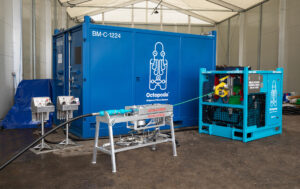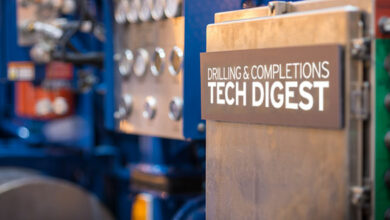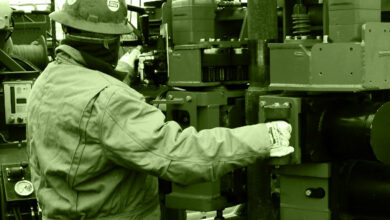Drilling & Completion Tech Digest


Remote piloting of ROV completed in UK from Norway
Oceaneering International has conducted the first onshore remote piloting of a remotely operated vehicle (ROV) in the UK sector for BP. The operations were conducted from Oceaneering’s Onshore Remote Operations Center (OROC) in Stavanger, Norway. This project was the first implementation of ROV remote piloting in the UK, the first cross-border implementation, and the first operational implementation for BP.
Oceaneering was tasked with observing drilling operations at BP’s Clair Ridge facility West of Shetland, at 141-m water depth. The operation ran from 20 July to 5 August 2021.
ROV remote piloting from shore can increase safety and reduce the environmental footprint of operations, potentially achieving up to 25% reduction in offshore personnel on board, and provide a significant reduction in emissions associated with the work.
To ensure secure offshore connectivity for the remote ROV piloting operations, a complex setup process was required to establish a bridge between the data networks of both companies without compromising their respective cybersecurity policies. The result was a secure data link via subsea optical fiber to the offshore worksite.
The Stavanger-based remote piloting team operated the ROV for over 70 hours during the campaign, with 100% uptime.
“By using experts located onshore in Norway instead of offshore personnel, the safety risk was reduced,” said Tom Fuller, VP Wells at BP North Sea. “It’s also a great example of how remote technologies can deliver emissions reductions on our assets.”
Maersk Drilling-developed RigFlow supports offshore drilling digitalization
For the past two years, Maersk Drilling has spearheaded an effort to develop a first-of-a-kind product to support digitalization of offshore drilling processes. The solution, known as RigFlow, has now been segregated into the digitally focused company named Horizon56, which will drive further development and commercialization.
The RigFlow solution standardizes and digitalizes the core workflows involved in the well construction process within offshore drilling operations, including real-time exchange of information between energy companies’ onshore planning units, the offshore drilling operations teams operating the rig, and the service companies supporting the operations. Other benefits of RigFlow include a user-friendly solution for providing digitalized drilling instructions, as well as automated reporting of data and insights to support quicker and deeper analysis of drilling operations.
Originally called Drilling Process Platform, RigFlow was developed by Maersk Drilling’s Innovation team from early ideation and validation in 2019. It has since been designed, tested and deployed across several Maersk Drilling rigs. Scoping and development have been performed in collaboration with digital leaders in the oil and gas sector, including Aker BP and Equinor.
Horizon56 was founded as a fully owned Maersk Drilling subsidiary and aims to attract investors to further develop the company and its products and services.

Expro intervention system reaches 300 m into annulus to restore pressure integrity
Expro has deployed its Octopoda annulus intervention system to restore annulus pressure integrity and return a well to production in the Piedemonte region of Colombia.
The system reached 300 m in the annulus, a world record depth, and sealed the C annulus of the well. This removed the risk of casing collapse and gas migration to enable the well to produce and significantly extend its production lifespan.
Expro collaborated with the client to design and execute this intervention operation. The cost was estimated to be approximately 25% less than the cost of a conventional workover rig-enabled repair.
Octopoda removed the need for a heavy workover rig while allowing for controlled circulation of annular fluids and the installation of a resin plug at the external casing shoe depth. This sealed the annulus and enabled production to be resumed.
Stena Drilling partners with SmartChainServices to develop smart contract solutions
Aberdeen-based Stena Drilling announced last year that it had acquired a minority stake in and formed a three-year technology partnership with SmartChainServices (SCS), a blockchain technology start-up based in Cambridge, UK.
The announcement follows a six-month proof-of-value project, where Stena Drilling applied SCS’ ClearDapp, a blockchain and smart contract technology. The goal was to reduce and eventually eliminate complex transactions related to IADC reporting and payment-for-rig-performance.
The companies will now work together to further develop smart contract solutions for the energy sector. With aims to automate and execute the payment cycle, the technology partnership will offer the energy industry new contractual models based on milestones, such as drilling speed, carbon intensity or fuel usage – all of which will be automatically validated through data.
“The sector faces tighter scrutiny around ESG from investors and society as the energy transition takes hold, and smart contract solutions offer a transparent way to demonstrate impact via tracking Scope 1 emissions at the rig, for example,” said Colin Dawson, Digital Business Transformation Manager of Stena Drilling. “We’re proud to play our part in progressing the sector.”
ClearDapp is built on R3’s Corda platform. In Q1 2022, SCS plans to deliver peer-to-peer transactions via the beta version of Corda’s payment module.

RSS alternative shows promise in downhole testing
Enteq Technologies recently saw successful results from the initial downhole and system testing of its SABER Tool. The tool was designed to be an alternative to traditional rotary steerable systems (RSS) for directional drilling. Testing included downhole qualification in a live drilling environment, as well as system testing exposing the tool to a range of dynamic scenarios to assess the efficacy of its control system and mechanics.
The SABER Tool, launched in February 2021, is an evolution of the proof of concept that was tested by Shell and licensed to Enteq. Enteq has re-engineered the concept, resulting in a mechanically simple, plain collar and compact design. The tool has undergone downhole and system testing to verify its ability to hold its directional tool face stationary under varying, dynamic downhole conditions. Results demonstrate that its simplified control system works to hold the geostationary platform.
“Whereas other tools have components that rotate with the collar, be that mechanical or electrical, the only thing rotating within the SABER Tool are the bearings. Everything else is stationary,” said Neil Bird, VP Advanced Drilling Systems, Enteq Technologies. “This principle of the tool means the downhole electronics are decoupled from damaging torsional vibration. In addition, we have increased the magnitude of the braking force to 10 times greater than the initial proof of concept.”
VALARIS DS-12 drillship is 1st rig to receive enhanced electrical system notation
The VALARIS DS-12 ultra-deepwater drillship has become the first vessel in the world to receive the ABS Enhanced Electrical System Notation EHS-E. Valaris upgraded the vessel’s electrical system to secure the notation, which recognizes sophisticated system design to improve reliability and enhance protection. The Valaris electrical system is specifically designed to allow the drillship to optimize power plant performance, enabling operations on fewer generators and reducing emissions.
ABS has surveyed the upgraded system and tested it to ensure it can operate on reduced generator power. The EHS-E notation was introduced in the ABS Guide for Dynamic Positioning Systems in October 2021.
Huisman demonstrates strength of composite tubulars in latest testing
Huisman recently demonstrated the strength of its composite tubulars in a test facilitated by the Rijswijk Centre for Sustainable Geo-energy. During the test, a 9 5/8-in. full composite pipe took 530 bar external pressure before it collapsed. With the shift from steel to composite materials, the Huisman Composite Tubulars tackle corrosion problems and reduce the potential for scaling. The transparent nature of the tubulars also enables measuring and logging activities to take place with ease through the tubular wall.




